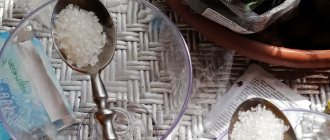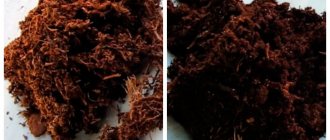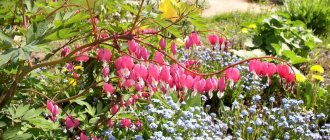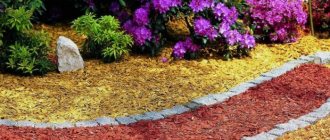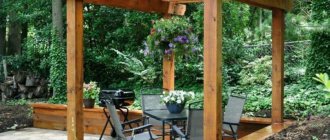Types and chemical composition of hydrogel
The hydrogel consists of granules packaged in sealed bags. The fine fraction material is used for germinating seeds, the larger fraction is added to the ground. Color and caliber do not affect the properties. There are several types of plant gel on sale:
- Balls that become soft upon contact with liquid. They do not damage plant roots, allow you to reduce the frequency of watering, and are optimal for germination and rooting of cuttings.
- Coarse colored fractions of various shapes. Designed for decoration.
- Completely soluble in water. Used to treat seeds before sowing.
The use of hydrogel for plants is safe, since the material is a sterile polymer that breaks down into water, carbon dioxide and ammonium.
A valuable property of this substance is its ability to absorb moisture as much as possible and gradually release it into the environment. Thus, 1 g of dry hydro granules can absorb up to 300 ml of liquid.
Advantages and disadvantages
The positive qualities of hydrogel for plants include:
- reducing germination time and increasing yield;
- pre-soaking the balls in fertilizer provides the plant with nutrients for a long time;
- the soil becomes loose and saturated with oxygen;
- when mixed with open ground, the probability of seedling survival increases;
- the use of hydrogel when planting a decorative lawn will preserve the greenery until late autumn;
- For 1 liter of soil only 1.5 g of dry powder is required.
The substance has few disadvantages:
- the hydrogel composition is not suitable for germinating legumes and sweet peas;
- prolonged exposure to the sun can lead to mold;
- if the substance is used in its pure form, it should be changed every two years.
To ensure the effectiveness of the granules, you should use it on your own plot or house plants.
What crops is it suitable for?
The use of hydrogel is possible when growing all moisture-loving plants. The polymer will create comfortable conditions for indoor flowers: chlorophytum, spurge, ivy, Kalanchoe, Crassula. Many inhabitants of the garden and vegetable garden will be pleased with the active growth and flowering when maintaining optimal soil moisture with gel balls. It is not recommended to use hydropellets for cacti, orchids and the aroid class.
Types of safe polymer
There are two categories sold in agricultural stores and florist centers:
- hydrogel,
- aqua soil.
The material differs not only in cost, but also in appearance. Each type of moisture-absorbing polymer mass has advantages and disadvantages.
The use of bright beads and translucent granular mixture is somewhat different. Before purchasing a safe polymer for indoor flowers, gardening and vegetable gardens for the first time, you need to find out which variety is suitable for a specific purpose, and find out the pros and cons of each category.
Soft
Main characteristics:
- The hydrogel base is a polymer, safe and non-toxic;
- granules are small in size, color is translucent, with a slight cloudy white tint;
- particles actively accumulate moisture;
- hydrogel is often mixed with soil, added to a flowerpot, under fruit trees or in the ground in garden beds;
- the main property is the ability to both absorb excess liquid in the substrate and gradually release water into the soil when the substrate dries out;
- The cost of the hydrogel is reasonable: a 20 g sachet costs about 40 rubles, a large weight (approximately 1 kg – about 800 rubles). The consumption is small: 2 tbsp. l. polymer granules absorb up to 3 liters of liquid;
- the soft structure allows the elements of the root system to easily pass between adjacent particles, absorbing life-giving moisture as necessary;
- certain types of indoor flowers and ornamental plants, such as bamboo, can be temporarily grown without adding a substrate if, for some reason, the gardener did not buy suitable soil in time;
- The polymer environment is an unsuitable place for the development of bacteria and fungi; there is no basis for the nutrition of microorganisms. For this reason, rot and bacterial infections never develop in the hydrogel;
- the soil becomes looser after adding polymer soft granules;
- in the garden and on the beds, using a modern moisture-absorbing agent, it is easy to remove melt water, which accumulates in excess during sudden warming;
- hydrogel is an additional component for delivering nutrients to plant roots, but when using a transparent polymer material, traditional fertilizers cannot be abandoned.
Dense
Helpful information:
- A more expensive type of hydrogel is called aquasoil.
- The granules are large, of various shapes: cube, ball, various shades, including bright ones.
- The cost is much higher than that of traditional moisture-absorbing material, and the product is not suitable for constant use in the garden.
- The hydrogel is suitable for growing plants for some time; aqua soil is used to create original floral compositions and interior design.
- Aqua soil is used by decorators and designers; flower growers rarely use aqua soil constantly: the plants dry out, grow poorly, and do not receive enough nutrients that are not contained in the synthetic material. For a very short period, you can place flowers in aqua soil to effectively decorate a green corner or after cutting flowers for a bouquet, but you will have to feed the specimen and follow other rules of use so that the plant does not die.
Main uses of hydrogel
The polymer is useful in open and closed ground, and is effective for indoor flowers. Several methods of using hydrogel for plants are practiced:
- as a substrate for germination and processing of seed material and cuttings;
- as a soil additive to maintain moisture;
- introduced into the hole when planting seedlings in unprotected soil;
- added to holes when planting garden trees and shrubs;
- for equipping landscape design elements.
How to apply - dry or swollen?
Depending on why the hydrogel is needed, it is used dry or moistened. For plants in pots and containers, soaked polymer is optimal; for gardening and vegetable gardens, dry substance is used. After watering or rain, the granules will absorb water and feed the plants with it for a long time. The dose of the applied gel depends on the quality of the soil, planting conditions and frequency of watering.
How to use for indoor plants?
The most productive hydrogel is for indoor plants. This product will be an excellent solution if you are unable to water your home flowers often. The granules are placed in holes or mixed with soil. Before adding, the polymer is soaked for an hour in settled water, after which the remaining liquid must be drained, and the finished balls must be mixed with soil and the pot must be filled with the mixture before planting. The amount of gel is 1 g per 200 ml.
If the flower is already planted in the soil
It is possible to add hydrogel to polka dots with already planted flowers. Using a stick, you need to carefully make indentations in the soil that reach the roots. Pour dry granules into them and pour over them. Once saturated with water, the gel will increase in size and can be displaced onto the surface. The excess must be removed and the holes covered with soil.
Using hydrogel for flowers without adding soil
Some plants can be grown directly in hydropellets. Here's how to use hydrogel for flowers without connecting to the ground:
- for irrigation, you should take settled water with nutritional supplements;
- the pot should not be in direct sunlight, otherwise plaque and mold will appear;
- add water as needed, preferably distilled, so that harmful microorganisms do not develop.
Hydrogel for protecting the exposed root system during planting, transplanting and transportation
In the garden, gel is used for rooting cuttings: the container is filled with swollen hydrogel and the sprout is placed in the middle. When planting seedlings in the ground, moistened granules are mixed with soil in a ratio of 1:5. In addition to moisturizing, they will provide air access to the root system, as the soil will become looser. You can make holes around the transplanted young trees and fill in the dry matter, sprinkling soil on top.
If you water it with a solution containing fertilizer, the tree will receive additional nutrition for a long time.
How to apply gel to already planted trees, bushes, and other crops?
You can add hydropellets to planted crops as follows:
- In the area around the trunk of a tree or bush, make punctures 20 cm deep. Pour dry gel into the holes and cover with soil. Water thoroughly twice at one-hour intervals.
- Place the soaked granules into the soil surface around the perimeter of the plant. It is better to do this manually so as not to damage the roots.
Hydrogel properties
A hydrogel is a polymeric substance in granular or powder form. It is characterized by the following qualities:
- hydrogel formula retains moisture and applied fertilizer;
- has a positive effect on the structure of the soil;
- prevents the appearance of cracks on the soil surface;
- promotes abundant flowering and fruiting.
- long period of validity (about 5 years).
Interacting with water, the hydrogel swells and increases in volume several times. The finished substance should be mixed with soil and the plant should be planted in the substrate. During germination, the root system will be moistened without additional watering for 15-20 days. The thicker the roots, the longer it will not require watering. After watering, the balls expand again without losing their functionality.
Types and composition of hydrogel for plants
There are two types of hydrogel for plants:
- Soft. It is used when planting indoor plants, germinating seeds and planting garden crops. Thanks to the softness of the granules, it is ideal for vegetation with delicate root systems. The roots grow inside the balls and become saturated with moisture.
- Dense (aqua soil). Its characteristic feature is multi-colored or shiny granules. Used as decoration for flower pots.
Aqua soil is not suitable for growing flowers. It can only be used for decorative purposes, for example for bouquets placed in a transparent vase.
These types of hydrogel are widely used by gardeners and designers because they have many advantages over regular soil.
Compound
The chemical composition of hydrogel for plants does not contain toxic elements and is completely safe for human and plant health. After the end of their service life, the components disintegrate and turn into organic substances.
Features of growing in hydrogel
Some nuances should be taken into account when working with gel:
- The granules need to be soaked only with settled or distilled water in a ratio of 1 gram of dry polymer per 300 ml;
- When planting in hydrogel, the roots are pre-washed. The sprout must be placed strictly vertically in the substrate,
- Watering is carried out 6 times less frequently; the need to add liquid can be easily determined by the slightly settled gel.
Adding to pots, containers
You can add hydrogel when transplanting indoor and garden plants into pots or other containers. Dry crystals are mixed with soil at the rate of 1 gram per liter of soil. The soaked gel is combined with the soil in a ratio of 1 to 5. The roots will grow into granules after 2 weeks, then reduce watering.
You can also add polymer to potting soil for planted flowers, pouring it dry into the holes.
Adding hydrogel to open ground
The hydrogel is effective for gardening when growing potatoes, tomatoes, herbs, carrots, beets, radishes, cabbage and cucumbers. You can add polymer when sowing, picking and transplanting seedlings into beds. It is necessary to add dry granules when digging, 25 g per square, followed by watering or into the holes, mixing the soaked gel with soil in a ratio of 1 to 5.
The depth of embedment depends on the root system: for surface – 10 cm, for buried – 25 cm.
Sowing seeds in hydrogel
To germinate seed material, hydropellets are soaked in a fertilizer solution, then rubbed through a sieve or crushed with a blender. Place 3 cm of substrate at the bottom of the container, place the seeds on top, lightly pressing them into the gel. The container is covered with film, making several holes in it for drainage. You can grow seedlings in a mixture of wet hydrogel and soil at a ratio of 1 to 3.
How to make hydrogel at home
Polymers are widely used in the manufacture of cosmetics and household products. There is no recipe for creating hydrogel at home. But to grow plants, you can use powder or granules extracted from other products, as an option - baby diapers.
Main stages of the process:
- clean diapers are briefly soaked in water to swell the granules;
- the diaper is cut and the contents are removed;
- The extracted granules are soaked and left for several hours to absorb moisture.
Since it is impossible to fully grow greens on pure gel, it is recommended to make a solution of nutrients for watering. Moreover, the concentration of the solution is reduced by half.
Calendar of gardening work using hydrogel for central Russia
| Types of jobs | Period |
| Sowing seeds for seedlings | From February to May |
| Planting in the ground, transplanting seedlings and seedlings | From April to June |
| Additive to the soil for planted garden crops | From April to October |
| Autumn transplantation of bushes and trees | From August to mid-October |
| Planting a young strawberry plantation | From July to September |
What is hydrogel used for?
Aqua soil and eco soil are common names for hydrogel. This substance, which absorbs and retains liquid, greatly facilitates the process of caring for house plants. The gel is produced in the form of powder or small granules. Most often used in the following cases:
- soil additive to maintain moisture levels;
- moisture-containing environment for plants during long-term transportation.
Flower growers often use powder to improve soil quality. By adding granules, it is possible to give clay soils a loose structure, and loose soils become somewhat lumpy.
Difference between hydrogel and aqua soil
Hydrogel and aqua soil are moisture-retaining polymers. The hydrogel was originally created as a soil additive to reduce the frequency of watering. Externally, the substance has the form of colorless granules or balls, which, when swollen, become deformed due to their lower density. Aqua soil is made on the basis of hydrogel for decorative use and is produced in the form of multi-colored figures. The thicker consistency allows it to retain its shape after soaking.
Aqua soil is not used for sowing seedlings and soil additives, since its moisture yield is much lower than that of hydrogel.
What is hydrogel for plants and how does it work?
According to the chemical formula, hydrogel refers to polymers (cross-linked copolymers) capable of holding large amounts of water and fertilizer solutions. The absorbency of the hydrogel is such that 1 g of dry matter can absorb 0.2-0.3 liters of water.
Dry hydrogel and saturated with water - an increase of 200-300 times!
For the hydrogel to start working, it must be added to the soil in the access area of the plant’s root system. Most often - in an already swollen state, saturated with water, less often - in a dry state (then it requires abundant watering immediately after application).
After 2-3 weeks, the plant’s roots will grow through the hydrogel capsules and will be able to absorb moisture from there without waiting for the next watering. The soil may dry out completely between waterings, but this will no longer be a shock to the root system. The hydrogel will be a backup source of water, which will prevent the plant from withering and drying out during dry periods.
The roots of the plant grow into the hydrogel and begin to be fed with water from there.
Hydrogel granules can be saturated not only with water, but also with fertilizer solutions. Then, in your absence, the flowers will not only not wither, but will also continue to feed “properly.”
Due to its ability to adsorb moisture, the hydrogel has another property: it will not allow the flowers to flood. All excess moisture that would normally drain through the drainage holes is absorbed into the hydrogel and then absorbed by the plant as needed.
I would like to immediately note that this article is not about Chinese hydrogel or, as it is also called, “aquasoil”. These are slightly different materials, although they have a similar polymeric nature. The purpose of agricultural hydrogel is to serve as a source of additional water for plants. The main purpose of aqua soil is a decorative effect.
Design application
You can effectively decorate your interior using aqua soil for plants. Colored granules of various shapes are filled into various transparent containers in which you can place indoor flowers or bouquets. The size and type of vase depends on the root system and height of the plant. Aqua soil can be used as a material for forcing bulbous flowers. Pour beautiful swollen balls into a tall glass and stir in a tulip bulb. After the bud appears, this composition is suitable for a present. It should be remembered that the polymer does not contain useful substances, therefore the plants living in it need feeding.
Advantages and disadvantages
The advantages of hydrogel include the following:
- high moisture-retaining characteristics;
- the ability to maintain soil moisture for a long time;
- acceleration of seed growth;
- prevention of leaching of useful substances from the soil;
- supplying roots and seeds with oxygen - this effect is achieved by loosening the soil;
- safety for people and plants;
- the ability to store unused substances in the refrigerator;
- prevention of water stagnation and rotting of the root system;
- reducing crop watering;
- attractive appearance;
- ease of use.
At the same time, hydrogel beads also have certain disadvantages:
- the risk of mold forming on the balls - this effect occurs with prolonged exposure to sunlight;
- impossibility of using seed material covered with a leathery shell and plants with large roots;
- impossibility of reuse;
- lack of nutrients in the structure.
